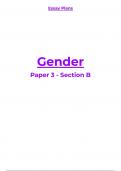Essay
Detailed essay plans covering all topics in Gender (AQA A-Level Psychology)
This document covers every possible essay that may come up for Gender (AQA A-Level Psychology). They are simplified and easy to learn yet still have lots of detail to ensure you achieve the highest grade possible. There are abbreviations throughout that you should understand as a psychology student...
[Show more]




